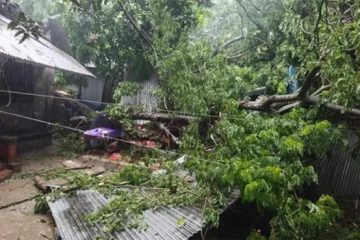The army led court of enquiry identified several reasons for the carnage at the Peelkhana BDR headquarters on February 25 and 26, the foremost being the deep resentment of BDR jawans against the ” Dal Bhat operation” launched during the last caretaker government.
More facilities for the army personnel compared with BDR jawans, non-payment of bills of the BDR jawans for duties in connection with the national elections and stoppage of illegal income of the BDR men have been cited as some of the major factors that incited them to stage the mutiny, according to a report submitted to the chief of army staff General Gen Moeen U Ahmed by the court of enquiry on May 11. The 20-member court of enquiry was headed by Lt.Gen. Md. Jahangir Alam Chowdury.
The report said that the BDR jawans used to work as sellers of fish and grocers in the Operation Dal Bhat and this hurt their dignity. Many of the jawans had to suffer punishment for this operation. Their signature on blank forms for making payment also created doubts in their minds and many harboured the belief that fund for the operation has been misappropriated, the report was stated to have mentioned.
The court of enquiry, however, found no proof of the involvement of militants in the BDR mutiny.
The report also blamed the intelligence agencies for their failure to forestall
the mutiny by taking prompt action in advance. Despite holding meeting with the political leaders on their demands by some BDR men, the intelligence agencies were dark about it, the report added.
Referring to the role played by the Home Minister Sahara Khatun and others, it said they could not take timely and effective measures for their lack of knowledge on military affairs.
It was also critical of the role of Rapid Action Battalion (Rab) for its inaction to put down the mutiny. The report pointed out that though a 350-member of Rab team was stationed at the three gates of Peelkhana after the mutiny, no permission was given to it to launch counter offensive against the mutineers. If the Rab was ordered to carry out offensive at that time the lives of the army officers could have been saved, it noted.
About the role of army to quell the mutiny, the report said the army could not be deployed on time as no rake could be carried out in advance for time constraint and absence of stock of required military equipment. Besides, the 46th brigade could not play its due role because of negotiation with the political leaders, the report mentioned.
The morale of the army broke down following the airing of the news of brutal killing of army officers and repression and insult to their family members.
The report accused the BDR men of breaking law while trying to enlist the support of the political leaders by meeting them.
The report held the view that many political and non-political leaders might have been angry with the army for helping the administration during the tenure of the caretaker government. These people might have used the mutiny as revenge against the army.
The report further said that Awami league leader subedar Torab Ali , his son Leather Liton and jawan Kanchon’s son Zakir stoked the mutiny by holding meeting with the BDR men.
Shedding light on killing and pillage at Peelkhana the report said at first 30 to 35 BDR jawans embarked on killing spree of army officers at Darbar Hall, DG building and other buildings. It later spread to other places. The court of equiry could not ascertain who killed the army officers and where. It could neither collect the names of the main planners of the mutiny. Most of the BDR jawans knew in advance about holding the army officers hostage but very few of them knew about killing of them, it said.
The report said 74 people including 57 army officers lost their lives in the mutiny.
During the carnage, the BDR jawans indulged in four types of crimes namely killing, repression on women and children, loot and holding hostage.
Disruption of electricity in the headquarters and removal of law enforcing agencies from the around the headquarters for reaching an understanding with political leadership paved the way for fleeing the BDR warns from the headquarters easily with light weapons, looted money and goods and other materials, it said.
The report further said that all the four battalions stationed at the BDR headquarters took part in the mutiny. Though the 44 rifles battalion saved their officers, the 36 rifles battalion killed their officers. The members of the BDR intelligence wings also took party in the mutiny directly.
The report put forward 27 recommendations. They include trial of the rebels under army rule, provision for capital punishment, reorganization of BDR, coordination of the whole affair and due compensation to those killed and wounded during the BDR carnage.
In all three committees were constituted to hold enquiry into BDR carnage separately.
The army team was headed by Lt.Gen. Janhangir Alam Chowdhury, the CID team by ASP Abdul Kahhar Akand and the government probe committee by former bureaucrat Anisuzzman.




















